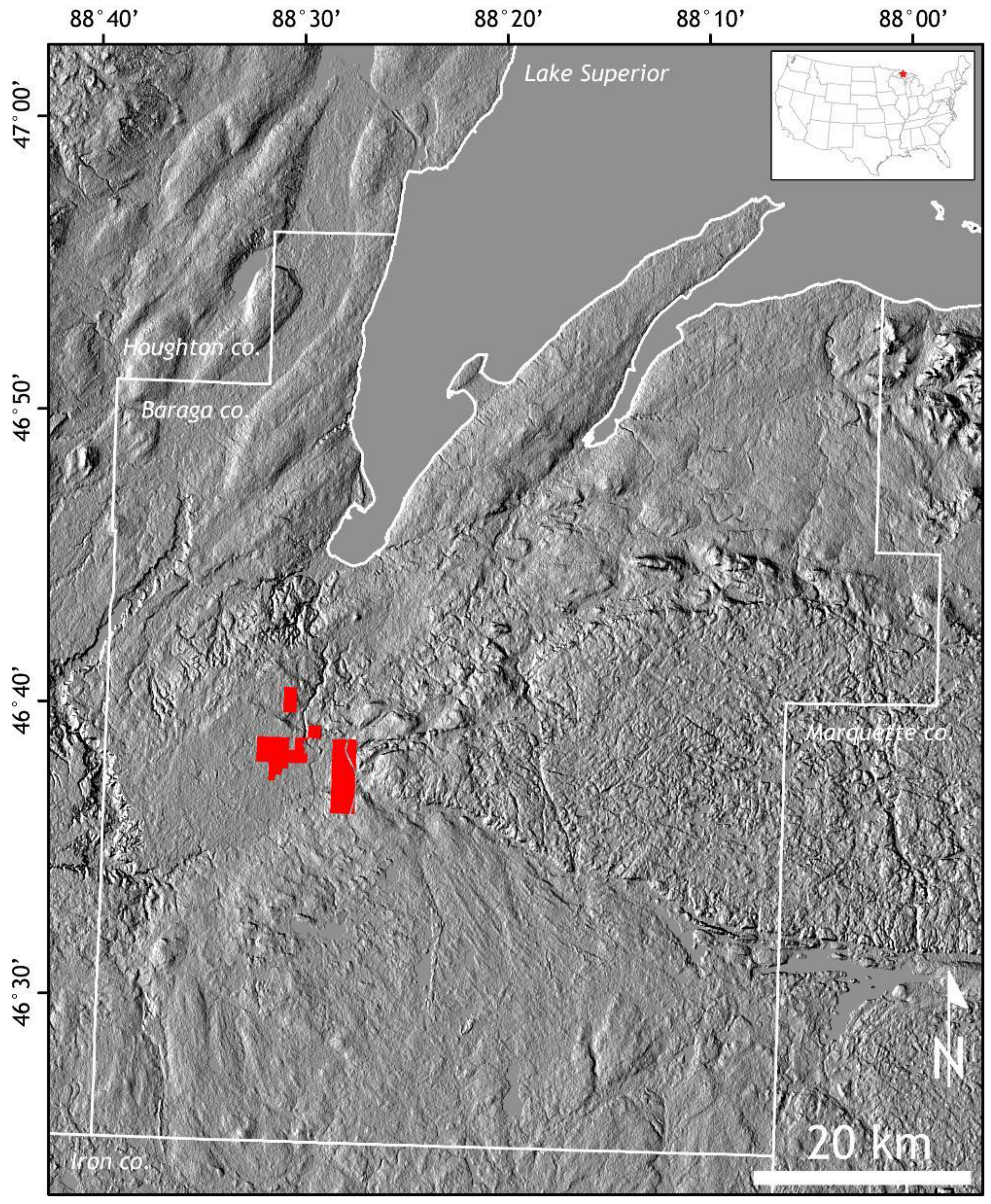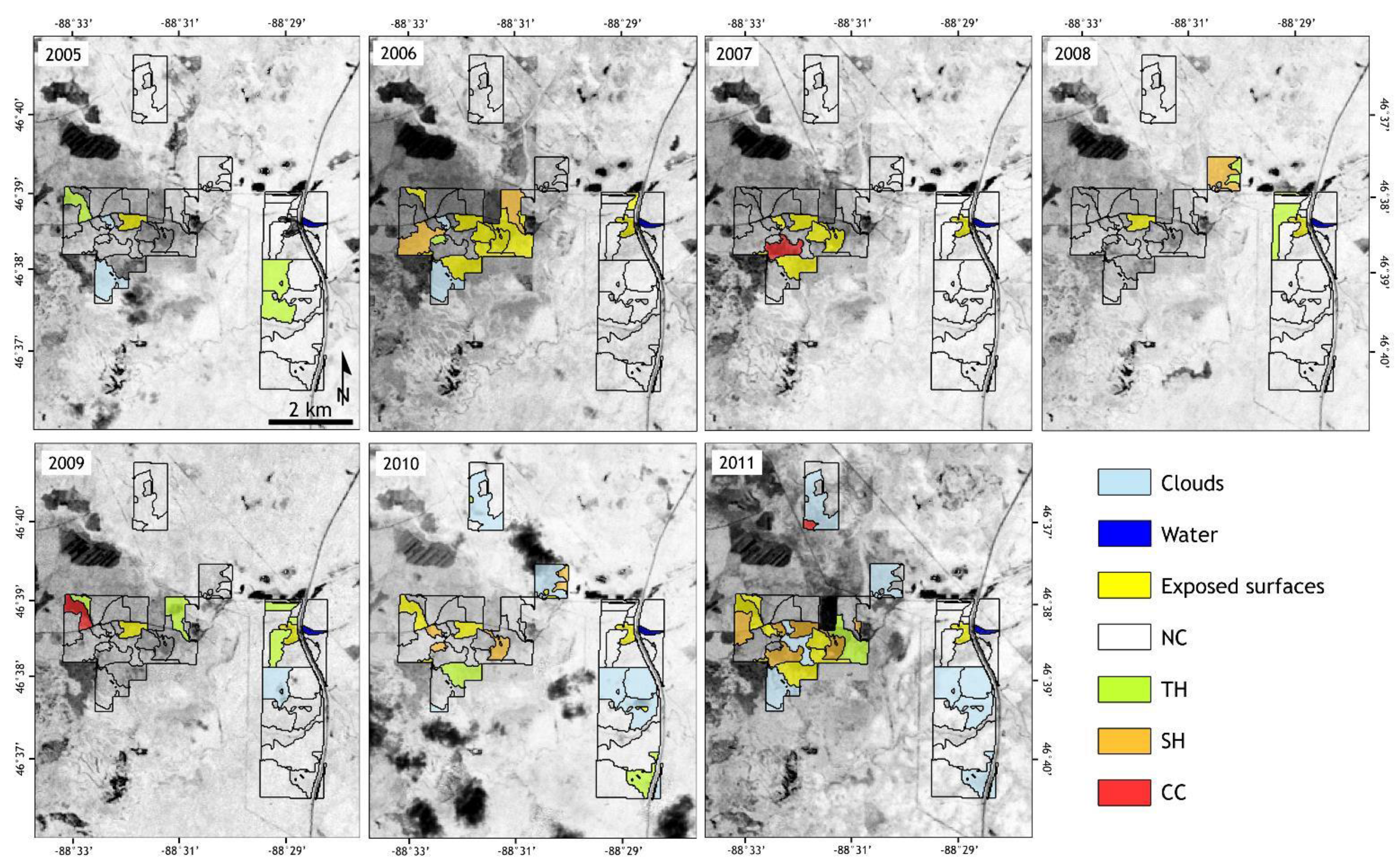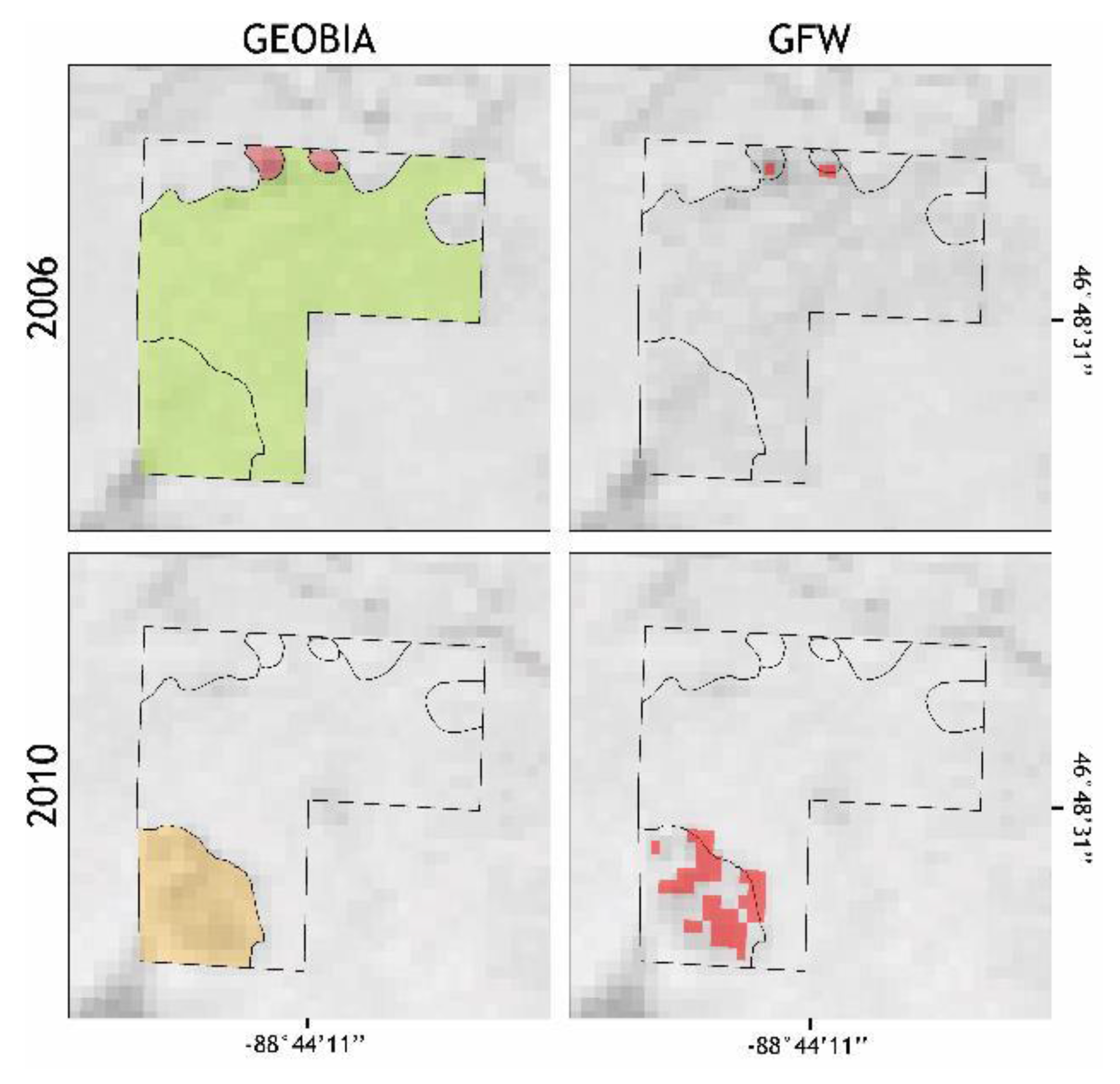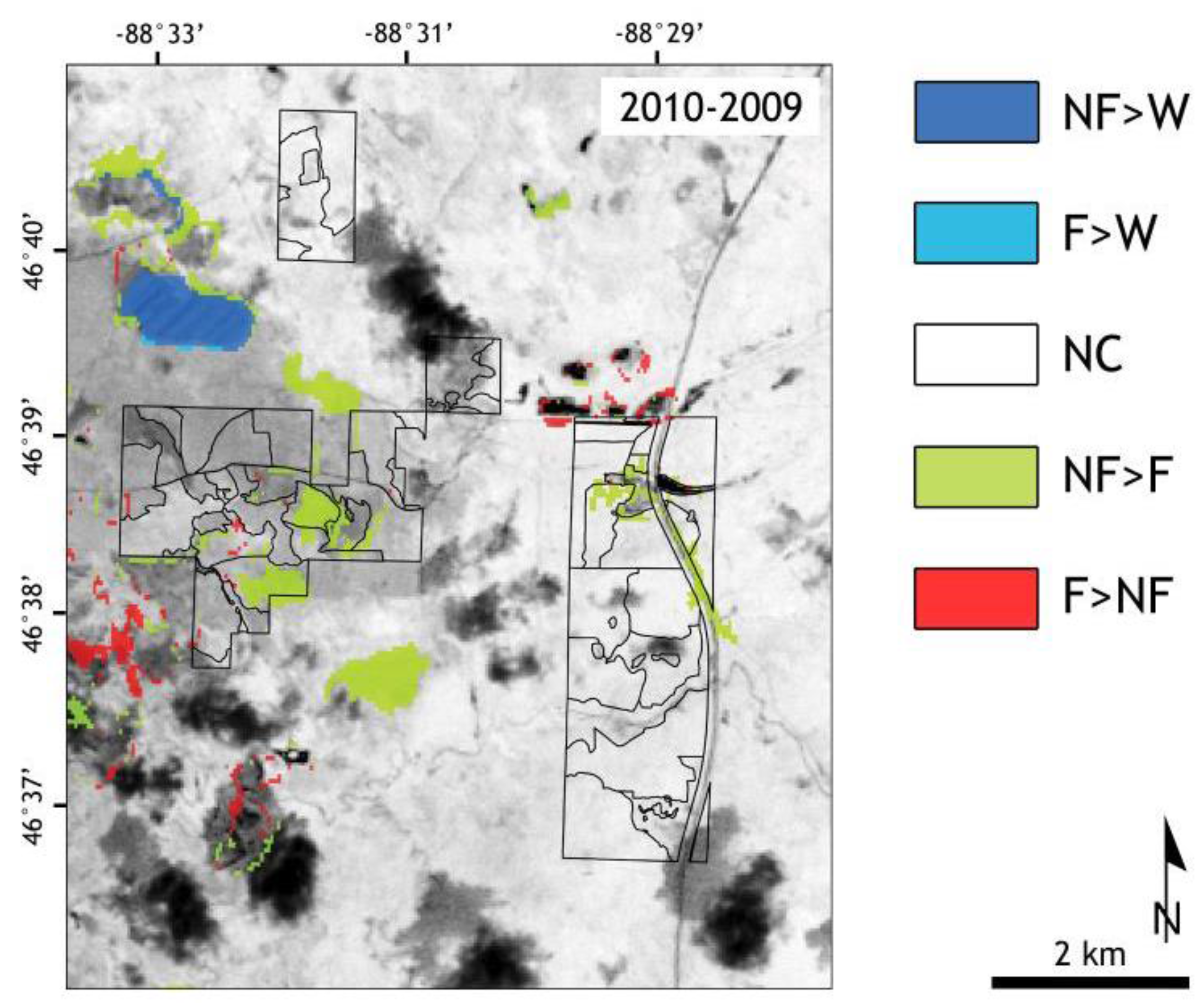Using an OBCD Approach and Landsat TM Data to Detect Harvesting on Nonindustrial Private Property in Upper Michigan
Abstract
:1. Introduction

2. Study Area and Dataset
3. OBCD Classification

4. Results

| Stand-Level | ||||
|---|---|---|---|---|
| NC | C | total | ||
| Predicted | NC | 203 | 4 | 207 |
| C | 14 | 10 | 24 | |
| Total | 217 | 14 | 231 | |
| Producer’s Accuracy | User’s Accuracy | Commission Error | Omission Error | F1 Score | G-measure | |
|---|---|---|---|---|---|---|
| NC | 0.98 | 0.95 | 0.05 | 0.02 | 0.96 | 0.96 |
| C | 0.50 | 0.67 | 0.33 | 0.50 | 0.53 | 0.55 |

| Year | Forest Type | BA% Removal (class) | Area (Acres) |
|---|---|---|---|
| 2006 | Northern Hardwood | 20 (TH) | 102 |
| 2006 | Aspen | 100 (CC) | 2 |
| 2010 | Oak seed tree | 70 (SH) | 19 |


5. Discussion
6. Conclusions
Acknowledgments
Author Contributions
Conflicts of Interest
References
- Hurtt, G.C.; Chini, L.P.; Frolking, S.; Betts, R.A.; Feddema, J.; Fischer, G.; Fisk, J.P.; Hibbard, K.; Houghton, R.A.; Janetos, A.; et al. Harmonization of land-use scenarios for the period 1500–2100: 600 Years of global gridded annual land-use transitions, wood harvest, and resulting secondary lands. Clim. Chang. 2011, 109, 117–161. [Google Scholar] [CrossRef]
- Smith, S.J.; Rothwell, A. Carbon density and anthropogenic land-use influences on net land-use change emissions. Biogeosciences 2013, 10, 6323–6337. [Google Scholar] [CrossRef]
- Edwards, D.P.; Gilroy, J.J.; Woodcock, P.; Edwards, F.A.; Larsen, T.H.; Andrews, D.J.R.; Derhe, M.A.; Docherty, T.D.S.; Hsu, W.W.; Mitchell, S.L.; et al. Land-sharing versus land-sparing logging: Reconciling timber extraction with biodiversity conservation. Glob. Chang. Biol. 2014, 20, 183–191. [Google Scholar] [CrossRef]
- Fischer, A.P.; Bliss, J.; Ingemarson, F.; Lidestav, G.; Lönnstedt, L. From the small woodland problem to ecosocial systems: The evolution of social research on small-scale forestry in Sweden and the USA. Scand. J. For. Res. 2010, 25, 390–398. [Google Scholar] [CrossRef]
- Mayer, A.L.; Rouleau, M.D. ForestSim model of impacts of smallholder dynamics: Forested landscapes of the Upper Peninsula of Michigan. Int. J. For. Res. 2013, 2013, 520207. [Google Scholar] [CrossRef]
- Butler, B.J. Family Forest Owners of the United States, 2006; Gen. Tech. Rep. NRS-27; U.S. Department of Agriculture, Forest Service, Northern Research Station: Newton Square, PA, USA, 2008; p. 72. [Google Scholar]
- Gustafson, E.J.; Loehle, C. Effects of parcelization and land divestiture on forest sustainability in simulated forest landscapes. For. Ecol. Manag. 2006, 236, 305–314. [Google Scholar] [CrossRef]
- Haines, A.L.; Kennedy, T.T.; McFarlane, D.L. Parcelization: Forest change agent in northern Wisconsin. J. For. 2011, 109, 101–108. [Google Scholar]
- Seymour, R.S.; White, A.S.; deMaynadier, P.G. Natural disturbance regimes in northeastern North America—Evaluating silvicultural systems using natural scales and frequencies. For. Ecol. Manag. 2002, 155, 357–367. [Google Scholar] [CrossRef]
- Kittredge, D.B.; Finley, A.O.; Foster, D.R. Timber harvesting as ongoing disturbance in a landscape of diverse ownership. For. Ecol. Manag. 2003, 180, 425–442. [Google Scholar] [CrossRef]
- Odum, W.E. Environmental degradation and the tyranny of small decisions. BioScience 1982, 32, 728–729. [Google Scholar] [CrossRef]
- Petrzelka, P.; Ma, Z.; Malin, S. The elephant in the room: Absentee landowner issues in conservation and management. Land Use Policy 2013, 30, 157–166. [Google Scholar] [CrossRef]
- Stone, R.N. 1970 A Comparison of Woodland Owner Intent with Woodland Practice in Michigan’s Upper Peninsula. Ph.D. Thesis, University of Minnesota, St. Paul, MN, USA, 1970. [Google Scholar]
- Franklin, S.E.; Lavigne, M.B.; Wulder, M.A.; Stenhouse, G.B. Change detection and landscape structure mapping using remote sensing. For. Chron. 2002, 78, 618–625. [Google Scholar] [CrossRef]
- Pocock, M.J.O.; Evans, D.M.; Memmott, J. The impact of farm management on species-specific leaf area index (LAI): Farm-scale data and predictive models. Agric. Ecosyst. Environ. 2010, 135, 279–287. [Google Scholar] [CrossRef]
- Binford, M.W.; Gholz, H.L.; Starr, G.; Martin, T.A. Regional carbon dynamics in the southeastern U.S. coastal plain: Balancing land cover type, timber harvesting, fire, and environmental variation. J. Geophys. Res.: Atmos. 2006, 111, D24S92. [Google Scholar] [CrossRef]
- Baker, B.A.; Warner, T.A.; Conley, J.F.; McNeil, B.E. Does spatial resolution matter? A multi-scale comparison of object-based and pixel-based methods for detecting change associated with gas well drilling operations. Int. J. Remote Sens. 2013, 34, 1633–1651. [Google Scholar] [CrossRef]
- Schiewe, J. Segmentation of high-resolution remotely sensed data: Concepts, applications and problems. Int. Arch. Photogramm. Remote Sens. Spat. Sci. Inf. 2002, 34, 380–385. [Google Scholar]
- Blaschke, T.; Lang, S.; Lorup, E.; Strobl, J.; Zeil, P. Object-oriented image processing in an integrated GIS/remote sensing environment and perspectives for environmental applications. Environ. Inf. Plan. Polit. Public 2000, 2, 555–570. [Google Scholar]
- Blaschke, T. Object based image analysis for remote sensing. ISPRS J. Photogramm. Remote Sens. 2010, 65, 2–16. [Google Scholar] [CrossRef]
- Chen, G.; Hay, G.J.; Carvalho, L.M.T.; Wulder, M.A. Object-based change detection. Int. J. Remote Sens. 2012, 33, 37–41. [Google Scholar] [CrossRef]
- Chen, G.; Zhao, K.; Powers, R. Assessment of the image misregistration effects on object-based change detection. ISPRS J. Photogramm. Remote Sens. 2014, 87, 19–27. [Google Scholar] [CrossRef]
- Heumann, B.W. An object-based classification of mangroves using a hybrid decision tree—Support vector machine approach. Remote Sens. 2011, 3, 2440–2460. [Google Scholar] [CrossRef]
- Dao, P.D.; Liou, Y.-A. Object-based flood mapping and affected rice field estimation with Landsat 8 OLI and MODIS data. Remote Sens. 2015, 7, 5077–5097. [Google Scholar] [CrossRef]
- Hall, O.; Hay, G.J. A multiscale object-specific approach to digital change detection. Int. J. Appl. Earth Obs. Geoinf. 2003, 4, 311–327. [Google Scholar] [CrossRef]
- Blaschke, T. Towards a framework for change detection based on image objects. In Remote Sensing & GIS for Environmental Studies: Applications in Geography; Erasmi, S., Cyffka, B., Kappas, M., Eds.; Göttinger Geographische Abhandlungen: Göttingen, Germany, 2005; Volume 113, pp. 1–9. [Google Scholar]
- Hay, G.J.; Castilla, G. Geographic Object-Based Image Analysis (GEOBIA): A new name for a new discipline. In Object Based Image Analysis—Spatial Concepts for Knowledge-Driven Remote Sensing Applications; Blaschke, T., Lang, S., Hay, G.J., Eds.; Springer-Verlag: Heidelberg, Germany, 2008; pp. 75–85. [Google Scholar]
- Townshend, J.R.G.; Justice, C.O. The spatial variation of vegetation at very large scales. Int. J. Remote Sens. 1990, 11, 149–157. [Google Scholar] [CrossRef]
- Goward, S.N.; Williams, D.L. Landsat and Earth systems science: Development of terrestrial monitoring. Photogramm. Eng. Remote Sens. 1997, 63, 887–900. [Google Scholar]
- Hansen, M.C.; Potapov, P.V.; Moore, R.; Hancher, M.; Turubanova, S.A.; Tyukavina, A.; Thau, D.; Stehman, S.V.; Goetz, S.J.; Loveland, T.R.; et al. High-resolution global maps of 21st century forest cover change. Science 2013, 342, 850–853. [Google Scholar] [CrossRef]
- Singh, A. Digital change detection techniques using remotely-sensed data. Int. J. Remote Sens. 1989, 10, 989–1003. [Google Scholar] [CrossRef]
- Lu, D.; Mausel, P.; Brondizio, E.; Moran, E. Change detection techniques. Int. J. Remote Sens. 2004, 25, 2365–2407. [Google Scholar] [CrossRef]
- Zhou, W.; Troy, A. An object-oriented approach for analysing and characterizing urban landscape at the parcel level. Int. J. Remote Sens. 2008, 29, 3119–3135. [Google Scholar] [CrossRef]
- Shimada, M.; Itoh, T.; Motooka, T.; Watanabe, M.; Shiraishi, T.; Thapa, R.; Lucas, R. New global forest/non-forest maps from ALOS PALSAR data (2007–2010). Remote Sens. Environ. 2014, 155, 13–31. [Google Scholar] [CrossRef]
- Scott, R.W.; Huff, F.A. Impacts of the Great Lakes on regional climate conditions. J. Great Lakes Res. 1996, 22, 845–863. [Google Scholar] [CrossRef]
- Röder, A.; Udelhoven, T.; Hill, J.; del Barrio, G.; Tsiourlis, G. Trend analysis of Landsat-TM and-ETM+ imagery to monitor grazing impact in a rangeland ecosystem in Northern Greece. Remote Sens. Environ. 2008, 112, 2863–2875. [Google Scholar] [CrossRef]
- Huang, C.; Goward, S.N.; Masek, J.G.; Thomas, N.; Zhu, Z.; Vogelmann, J.E. An automated approach for reconstructing recent forest disturbance history using dense Landsat time series stacks. Remote Sens. Environ. 2010, 114, 183–198. [Google Scholar] [CrossRef]
- Kennedy, R.E.; Yang, Z.; Cohen, W.B. Detecting trends in forest disturbance and recovery using yearly Landsat time series: 1. LandTrendr—Temporal segmentation algorithms. Remote Sens. Environ. 2010, 114, 2897–2910. [Google Scholar] [CrossRef]
- Rouse, J.W., Jr.; Haas, R.H.; Schell, J.A.; Deering, D.W. Monitoring vegetation systems in the Great Plains with ERTS. In Proceedings of the 3rd Earth Resources Technology Satellite-1, Washington, DC, USA, 10–14 December 1973; pp. 309–313.
- Huete, A.R.; Didan, K.; Miura, T.; Rodriguez, E.P.; Gao, X.; Ferreira, L.G. Overview of the radiometric and biophysical performance of the MODIS vegetation indices. Remote Sens. Environ. 2002, 83, 195–213. [Google Scholar] [CrossRef]
- Huete, A.R. A Soil-Adjusted Vegetation Index (SAVI). Remote Sens. Environ. 1988, 25, 295–309. [Google Scholar] [CrossRef]
- Liu, H.Q.; Huete, A.R. A feedback based modification of the NDVI to minimize canopy background and atmospheric noise. IEEE Trans. Geosci. Remote Sens. 1995, 33, 457–465. [Google Scholar]
- Maianti, P.; Rusmini, M.; Tortini, R.; Dalla Via, G.; Frassy, F.; Marchesi, A.; Rota Nodari, F.; Gianinetto, M. Monitoring large oil slick dynamics with moderate resolution multispectral satellite data. Nat. Hazards 2014, 73, 473–492. [Google Scholar] [CrossRef]
- Powers, D.M.W. Evaluation: From precision, recall and F-measure to ROC, informedness, markedness & correlation. J. Mach. Learn. Technol. 2011, 2, 37–63. [Google Scholar]
- Stehman, S.V.; Czaplewski, R.L. Design and analysis for thematic map accuracy assessment: Fundamental principles. Remote Sens. Environ. 1998, 64, 331–344. [Google Scholar] [CrossRef]
- Congalton, R.G. A review of assessing the accuracy of classifications of remotely sensed data. Remote Sens. Environ. 1991, 37, 35–46. [Google Scholar] [CrossRef]
- Janssen, L.L.F.; Wel, F. Accuracy assessment of satellite derived land cover data: A review. IEEE Photogramm. Eng. Remote Sens. 1994, 60, 419–426. [Google Scholar]
- Markham, B.L.; Storey, J.C.; Williams, D.L.; Irons, J.R. Landsat sensor performance: History and current status. IEEE Trans. Geosci. Remote Sens. 2004, 42, 2691–2694. [Google Scholar] [CrossRef]
- GOFC-GOLD. A Sourcebook of Methods and Procedures for Monitoring and Reporting Anthropogenic Greenhouse Gas Emissions and Removals Associated with Deforestation, Gains and Losses of Carbon Stocks in Forests Remaining Forests, and Forestation, GOFC-GOLD Report version COP18–1; GOFC-GOLD Land Cover Project Office, Wageningen University: Wageningen, The Netherlands, 2012. [Google Scholar]
- Desclée, B.; Bogaert, P.; Defourny, P. Forest change detection by statistical object-based method. Remote Sens. Environ. 2006, 102, 1–11. [Google Scholar] [CrossRef]
- Linke, J.; McDermid, G.J.; Laskin, D.N.; McLane, A.J.; Pape, A.; Cranston, J.; Hallbeyer, M.; Franklin, S.E. A disturbance-inventory framework for flexible and reliable landscape monitoring. Photogramm. Eng. Remote Sens. 2009, 75, 981–995. [Google Scholar] [CrossRef]
- Dorren, L.K.; Maier, B.; Seijmonsbergen, A.C. Improved Landsat-based forest mapping in steep mountainous terrain using object-based classification. For. Ecol. Manag. 2003, 183, 31–46. [Google Scholar] [CrossRef]
- Bontemps, S.; Bogaert, P.; Titeux, N.; Defourny, P. An object-based change detection method accounting for temporal dependences in time series with medium to coarse spatial resolution. Remote Sens. Environ. 2008, 112, 3181–3191. [Google Scholar] [CrossRef]
- Bengston, D.N.; Asah, S.T.; Butler, B.J. The diverse values and motivations of family forest owners in the United States: An analysis of an open-ended question in the National Woodland Owner Survey. Small-Scale For. 2011, 10, 339–355. [Google Scholar] [CrossRef]
- Beach, R.H.; Pattanayak, S.K.; Yang, J-C.; Murray, B.C.; Abt, R.C. Econometric studies of non-industrial private forest management: A review and synthesis. For. Policy Econ. 2005, 7, 261–281. [Google Scholar] [CrossRef]
- Butler, B.J.; Ma, Z. Family forest owner trends in the northern United States. North. J. Appl. For. 2011, 28, 13–18. [Google Scholar]
- Moser, W.K.; Leatherberry, E.C.; Hansen, M.H.; Butler, B.J. Farmers’ objectives toward their woodlands in the upper Midwest of the United States: Implications for woodland volumes and diversity. Agrofor. Syst. 2009, 75, 49–60. [Google Scholar] [CrossRef]
© 2015 by the authors; licensee MDPI, Basel, Switzerland. This article is an open access article distributed under the terms and conditions of the Creative Commons Attribution license (http://creativecommons.org/licenses/by/4.0/).
Share and Cite
Tortini, R.; Mayer, A.L.; Maianti, P. Using an OBCD Approach and Landsat TM Data to Detect Harvesting on Nonindustrial Private Property in Upper Michigan. Remote Sens. 2015, 7, 7809-7825. https://doi.org/10.3390/rs70607809
Tortini R, Mayer AL, Maianti P. Using an OBCD Approach and Landsat TM Data to Detect Harvesting on Nonindustrial Private Property in Upper Michigan. Remote Sensing. 2015; 7(6):7809-7825. https://doi.org/10.3390/rs70607809
Chicago/Turabian StyleTortini, Riccardo, Audrey L. Mayer, and Pieralberto Maianti. 2015. "Using an OBCD Approach and Landsat TM Data to Detect Harvesting on Nonindustrial Private Property in Upper Michigan" Remote Sensing 7, no. 6: 7809-7825. https://doi.org/10.3390/rs70607809
APA StyleTortini, R., Mayer, A. L., & Maianti, P. (2015). Using an OBCD Approach and Landsat TM Data to Detect Harvesting on Nonindustrial Private Property in Upper Michigan. Remote Sensing, 7(6), 7809-7825. https://doi.org/10.3390/rs70607809








